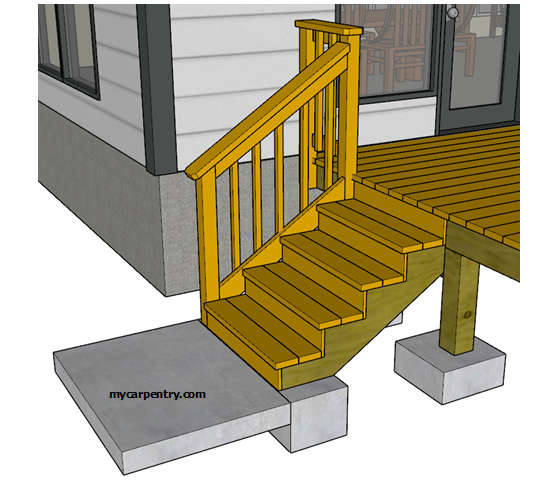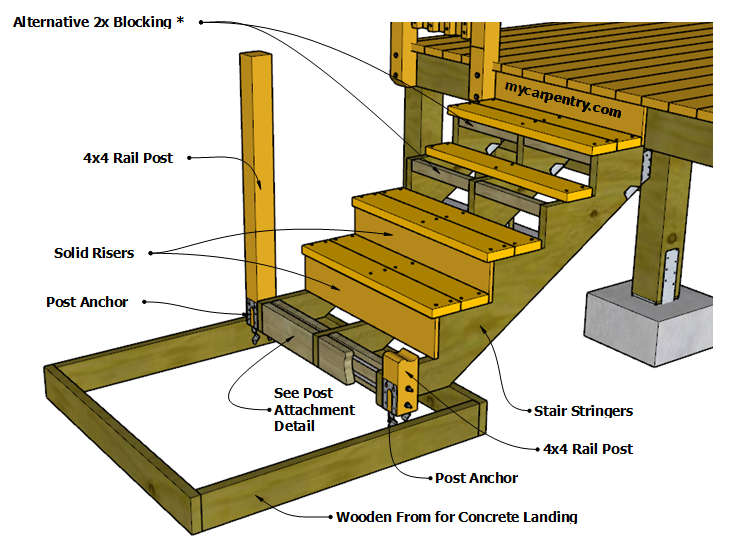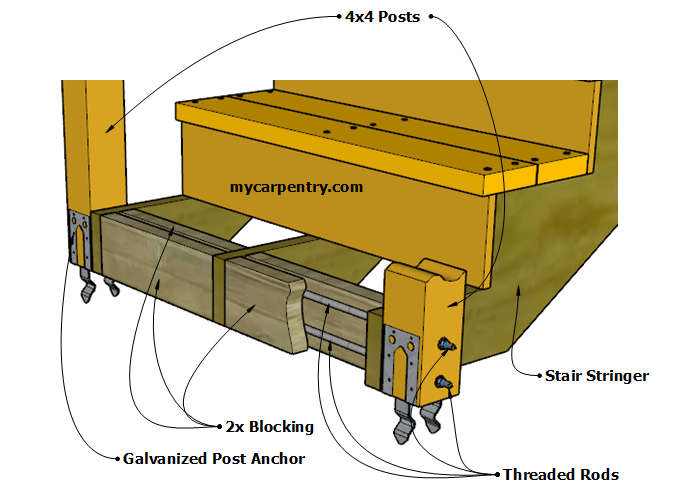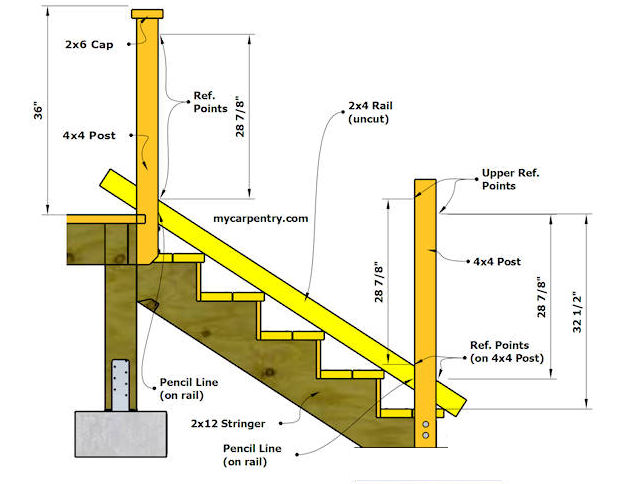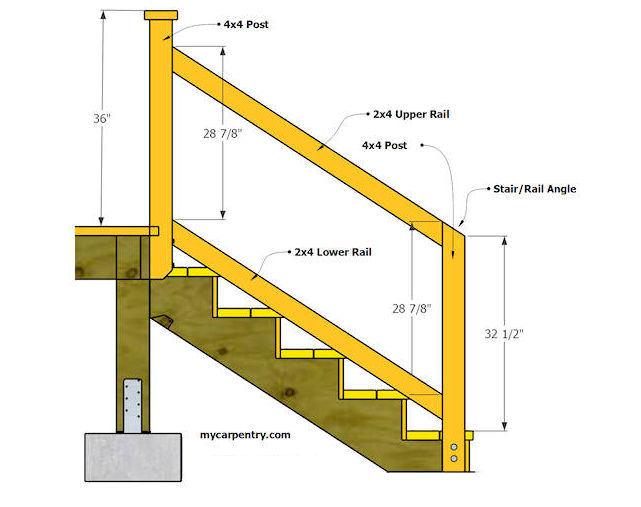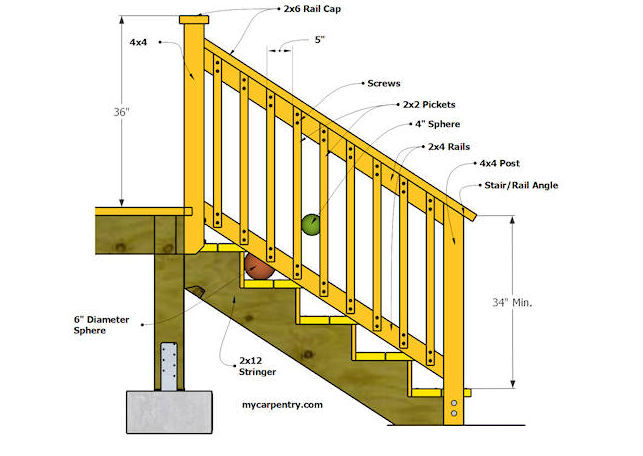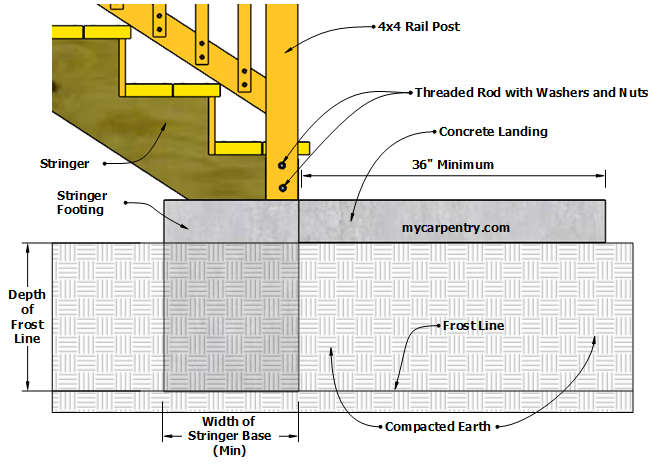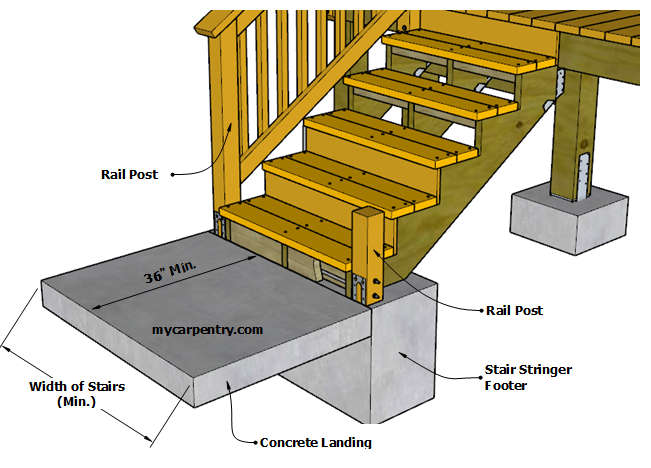Stair Railing (7)
Stair Railing (Part 7 of 7) will show you how to build railing for the stairs you constructed using Part 5 (Building Deck Stairs)) of the deck building tutorial.
Stair railing is needed if your deck is 30" (762 mm) above the ground. Always check your local building code before building a deck. The Prescriptive Wood Deck Construction Guide by the American Wood Council is an excellent source for deck building codes.
This tutorial assumes that stair stringers have been cut and attached to the deck and a wooden form is present for the future concrete footing and landing. See Building Deck Stairs for details. Further, it assumes that at least one section of deck railing is in place so that there is an upper rail post at the top of the stairs. See Deck Railing.
Stair Railing - Base Posts
Cut two 4x4 rail posts about 4 feet long (1219 mm) and attach a galvanized post anchor to the bottom end of each post. Attach the 4x4 posts to the ends of each outside stringer using two 2-1/2-inch galvanized deck screws (screwed from the inside of the stringers) to hold them in place. To determine the length of the galvanized threaded rods, measure the span between the outside of each post and add 2 inches.
The threaded rod should stick past the 4x4 posts an inch on each side.
Ensure the two lower 4x4 posts are plumb. Drill two 5/8" holes through the outside of both 4x4 posts and the three stringers. Thread the 1/2" diameter rods through the 5/8" holes. Add 2x blocking between the stringers behind and in front of the threaded rods. Once the blocking is in place, add washers and nuts to the ends of the two rods and tighten. The 4x4 posts should be straight-up plumb and securely fastened to the stringers.
Determine the Rail Angle
Place an uncut section of 2x4 rail material across the ends of the treads, up against the 4x4 posts. Add a small pencil mark (referred to as Ref. Points in diagram [C]) on the front and back of the lower 4x4 post and on the front of the upper 4x4 post, where they intersect with the top of the 2x4 rail material (diagram [C]). You can also determine the Stair/Rail angle by placing a Speed Square where the 2x4 and 4x4 intersect.
Note: If you used the Stair Calculator to determine the rise and run of your stringers, the Stair/Rail Angle is provided in the calculation.
Place the 2x4 rail material tight against the upper and lower posts and mark the inside face of it along both upper and lower 4x4 posts. Cut it and use it as a template for the second rail.
On the front of the lower post, make a small mark at 32 1/2" from the top of the tread on the first step. On the Upper Reference Point (diagram [C]), mark the rail angle on the post. Transfer the marks around the 4x4 post and cut it with a circular saw.
Note: When you add the 1 1/2" (38 mm) 2x6 rail cap to the 32 1/2" (825 mm) post, you get 34" (864 mm), the minimum recommended stair rail height.
Once the angle has been cut on the top of the lower post, measure (on the front) the distance between the lower Ref. Point to the angle cut (shown as 28 7/8" in diagram [C]). To determine the position of the upper 2x4 rail on the upper 4x4 post, transfer that same measurement to the upper post as shown in the diagrams.
Note: The 28 7/8" used in the diagrams is just for example purposes. Your measurements between reference points will likely be different. This measurement helps to determine where the upper rail will attach to the upper post.
The vertical position of the lower 2x4 rail does not have to be as shown in the diagrams. The only important factor is that a 6" (153 mm) sphere should not be able to pass between the steps and the lower rail.
Attach the upper and lower 2x4 rails to the 4x4 posts using two 3-inch deck screws at each end, as shown in diagram [D]. Layout for the pickets is the same method used on the Deck Railing (6) section of the 10x10 deck tutorial. Essentially, find the center between 4x4 posts, and at 5" centers, and determine run-out on the pickets to make sure the end pickets will not fall too close or too far away from each post.
The spacing of the pickets should not allow the passage of a 4" sphere. 5" on center spacing should be more than adequate.
Cut and Install the Balusters
Using a level, transfer the baluster layout lines to both rails and measure vertically from the top of the upper rail to the bottom of the lower rail to determine the height of the ballisters. The angle on the top of the 2x2 balusters is the same as the top of the lower 4x4 posts. Attach the pickets using two 2-1/2-inch deck screws on both ends of each picket.
Attach the 2x6 rail cap as shown in the diagram above.
Concrete Footing and Landing
The building code for stair stringer footings suggests that they be at least 12 inches deep or to the depth of the frost line. If the frost line in your area is 24 inches, then the depth of the footing must be 24 inches.
In our design, the stringer footing should be at least 4 inches wider than the span between the outsides of each post so that there is a minimum of 2 inches of concrete extending from each side of the base rail posts. The length (front to back) should be as long as the base of the stringers.
Note that the earth below the ground level can serve as a form for footings.
The minimum width of the landing at the base of the stairs must be the same as the stair width. The minimum depth must be no less than 36 inches.
** Note: For building code information related to stair construction, visit 2024 International Residential Code for One- and Two-Family Dwellings - Section 318 - MEANS OF EGRESS.
For building code information related to deck building, check out the Prescriptive Residential Wood Deck Construction Guide by the American Wood Council.
Deck Railing - Learn how to build deck railing.
Building Deck Stairs - How to build stairs for a deck.
Stair Calculator - Calculate stair rise and run and stringer layout.
Deck Footings - Learn about footing sizes and depths for decks.
What next?
Return to Carpentry Projects.
Leave Stair Railing and return Home.


